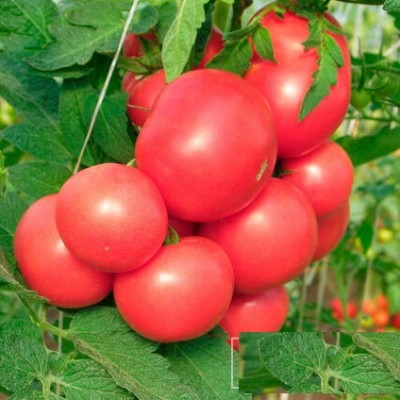
- Authors: Lukyanenko A.N., Dubinin S.V., Dubinina I.N., Agrofirma SEDEK LLC
- Year of approval: 2007
- Category: hybrid
- Growth type: indeterminate
- Appointment: fresh consumption
- Ripening period: early
- Ripening time, days: 105-110
- Growing conditions: for open ground, for film greenhouses
- Marketability: Yes
- Bush size: tall
Tomato Major is a fairly new variety and deservedly popular among summer residents throughout the country. These are mid-early tomatoes, distinguished by their presentable appearance and excellent taste. At the same time, its unpretentiousness and ease of cultivation are often noted. The variety is often referred to as F1 Major.
Breeding history
Tomato Major was officially registered in the register for distribution in 2007, but gained special fame only in 2009. The company that created an excellent hybrid in terms of performance is LLC Agrofirma SEDEK. Lukyanenko A.N., Dubinin S.V., Dubinina I.N.It was thanks to their work that the variety, originally intended for cultivation only in greenhouses, began to be actively cultivated in the open soil.
Description of the variety
The breeders managed to develop a high-yielding, unpretentious variety intended for use both in the south of the country and in more northern, less fertile lands.
Due to the climatic conditions of different regions, cultivation tips differ slightly according to climatic conditions. In the south of the country, seedlings are calmly planted in open ground, while more northern regions, due to unstable temperatures, prefer to grow tomatoes in specially equipped greenhouses.
The main qualities of the fruit
The impression on summer residents and producers is produced by the fruits of the plant, which have several advantageous characteristics.
The main shape is round.
The skin is thin and yet quite firm, making it ideal for salads and eaten raw.
Initially it has a bright emerald green hue.
When ripe, the tomato becomes deep pink or raspberry.
They have a convenient average size from 200 to 300 grams.
Taste characteristics
The fresh, rich taste of tomatoes is striking in its depth. Due to its high sugar content, the pulp tastes sweet and sour. The fruits are distinguished by increased fleshiness, juiciness, and have a stable strong aroma.
Ripening and fruiting
Variety Major belongs to medium-yielding. The duration of the growing season is 105-110 days from the moment of the first shoots, which makes it possible to classify the variety as early in terms of maturity. At the same time, the bushes can rise to a height of 1.8 meters and require additional attention and a garter so that the stem does not break off under the weight of the fruit.
Yield
For a year, from a square meter, subject to all planting rules, it is possible to remove up to 8-12 kilograms of product. Due to its high yield, it won the love of agricultural producers.
The timing of planting seedlings and planting in the ground
Sowing seedlings usually takes place in March. The seeds are pre-disinfected in a special solution, and then planted in containers and boxes for growing seedlings, filled with specialized soil with nutritional supplements.
At the end of May - the very beginning of June, the seedlings are transplanted into prepared open ground in the southern regions and greenhouses in the northern ones. Previously, the soil is loosened and the necessary moisture is provided so that the plants quickly take up in a new place.

Growing tomato seedlings is an extremely important process, because it largely depends on whether the gardener will be able to harvest at all. All aspects must be taken into account, from seedbed preparation to planting in the ground.
Landing scheme
Due to the peculiarities of growth and size of the bushes, they are planted, observing the space between the individual bushes at 40 cm, and between the rows at 70. This will allow the bush to give the maximum number of fruits. When forming a bush, 2-3 stems remain.

Growing and care
Tomato Major does not require particularly careful maintenance. However, it is necessary to tie up the bushes and, if necessary, introduce special feeding. The variety reacts especially well to fertilizers with potassium and phosphorus in the composition.




A plant needs different micronutrients at each stage of growth. All fertilizers can be divided into two groups: mineral and organic. Folk remedies are often used: iodine, yeast, bird droppings, eggshells.
It is important to observe the rate and period of feeding. This also applies to folk remedies and organic fertilizers.
Disease and pest resistance
Has increased resistance to most common diseases of tomato crops. Major showed excellent resistance to fungal diseases, cladosporia, verticillosis, tobacco mosaic virus. However, during the ripening period, special attention should be paid to the integrity of the fruit. Cracking is not a common problem with other varieties, but the Major can be prone to it.


Resistant to adverse weather conditions
The tomato is a hybrid variety. When breeding, the authors sought to obtain not only juicy tasty fruits, but also to develop the plant's resistance to various growing conditions. Resistance to unfavorable weather conditions, sharp temperature changes in the variety is assessed as high.
Growing regions
Due to their unpretentiousness and resistance to weather changes, Major tomatoes are successfully grown in a number of regions.
Northwestern.
Far Eastern.
Volgo-Vyatsky.
CChO.
North Caucasian.
Middle Volga.
Nizhnevolzhsky.
Uralsky.
Central.
West Siberian.
East Siberian.
Northern.

























































































